Installation view of Ben Hughes, Sweet. Left to right, Mickey Wands All Day 2024, 33 X 53cm, Latex, silicone, oil paint, enamel and glass on wooden board. Circus Crystal 2024, 40 X 40cm, Latex, silicone, oil paint, enamel and glass on wood board. The Boys 2024, 37 X 52cm, Latex, silicone, oil paint, ink on wood board. Untitled 2024, Dimensions variable, vintage Nation TV, LG VCR player, Las Vegas video (duration 20:00 mins). $weet Pussy 2024, 60 X 40cm, Oil paint and carbon residue on canvas. Strawberry. Photo courtesy: Nicholas Mahady and Strawberry
Sweet
Jeremy George
It has been said we are living in the golden age of body-horror. The massive hype around films released this year like The Substance and A Different Man (or Poor Things from 2023) does seem to signal a new lease on life for the genre. Like more classic films of the genre, they centre outsiders who have been marginalised by society to some extent by forms of discrimination. But what seems to distinguish these more recent films from older body-horror (like Cronenberg’s 1983 Videodrome, for example) is their interest in using the immediately visceral effect of gore and corporality to prosecute not only a critique of society’s ills but also to interrogate their own. These films focalise the tense space between critique and complicity or empathy and exploitation that the artistic gaze occupies when it turns to the themes and subjects of marginalisation as its material. To my mind, this is why there has been such a polarised response to The Substance. Is it really a feminist call to arms? Or are its lingering (and endlessly repetitive) shots of both generically hot and outlandishly grotesque naked women simply a more vulgar rehashing of the same-old exploitative gaze Laura Mulvey identified in Hitchcock, only now under the legitimating guise of satirical critique? Part of the film’s drama and the enjoyment it has excited from viewers seems to hinge on the idea that both might plausibly be true.
Nicely timed for Halloween weekend, Ben Hughes’s show Sweet at Strawberry seems to participate in this body-horror zeitgeist. Like recent films, the show centres a figure marginalised from society, albeit a more historical one: the clown. Importantly, Hughes’s choice of clown as protagonist also registers the exhibition’s meta interest: addressing the potentially exploitative or parasitical relationship between artmaking and outsider subjects. After all, clowns and artists have a complicated history. Clowns have been instrumentalised as a tragic point of identification for the limitations faced by the artist as in Stéphane Mallarmé’s ‘The Clown Chastised’ (arguably a proto body-horror poem). But they have also been made to represent the artist’s genius. In his romantic Rose Period (1904-6), for example, Pablo Picasso harnessed the freeing energies of the carnivalesque circus unbeholden to inherited conventions and orthodoxies to claim jester’s privilege for the artist. Later, although clown figures disappeared from his work, he converted the checked costumes of the harlequin figures in his earlier pieces into the tessellated patterns of his analytic Cubism. Joan Miró also famously turned to the harlequin to inform the abstract energies of his most successful surrealist pictures.
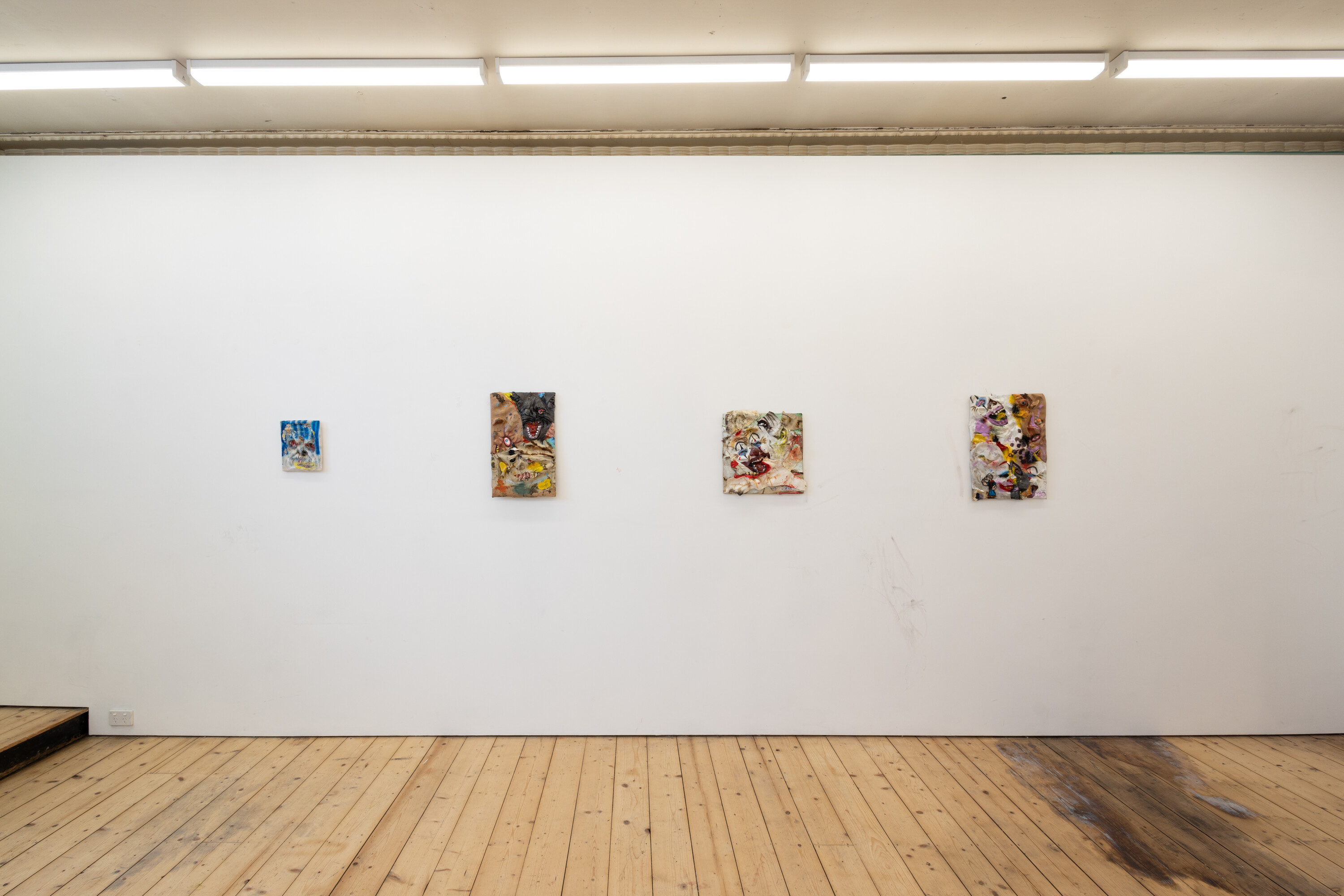
Installation view of Ben Hughes, Sweet. Left to right, Rugby 2024, 20 X 25cm, Plastic bag, ink, silicone, enamel and glass on canvas board. Mickey Wands All Day 2024, 33 X 53cm, Latex, silicone, oil paint, enamel and glass on wooden board. Circus Crystal 2024, 40 X 40cm, Latex, silicone, oil paint, enamel and glass on wood board. The Boys 2024, 37 X 52cm, Latex, silicone, oil paint, ink on wood board. Strawberry. Photo courtesy: Nicholas Mahady and Strawberry
Sweet is the fifth show at Grace Anderson and Caesar Florence-Howard’s gallery since its opening in July this year, and it represents some of their general aesthetic preoccupations. For example, Hughes has used an ominous “carbon residue” to scribble skid marks all over the white walls of the gallery. Whilst I really want to interpret this is as some sort of dirty protest, Strawberry’s general predisposition for grime and refuse makes me wonder if it’s something of a ritual for shows to involve defacing the gallery’s infrastructure (excluding, of course, Abella D’Adamo’s one-night art fashion happening, which explored a very different experience of abjection). Hughes’s gesture is at least evocative of the blood red paint splattered on the walls for the gallery’s inaugural offering by Nicola Blumenthal, and its ashy-white residue also evokes the stale colour schemes of subsequent shows by Jeb Costin and James Ashley and Thomas Miller.
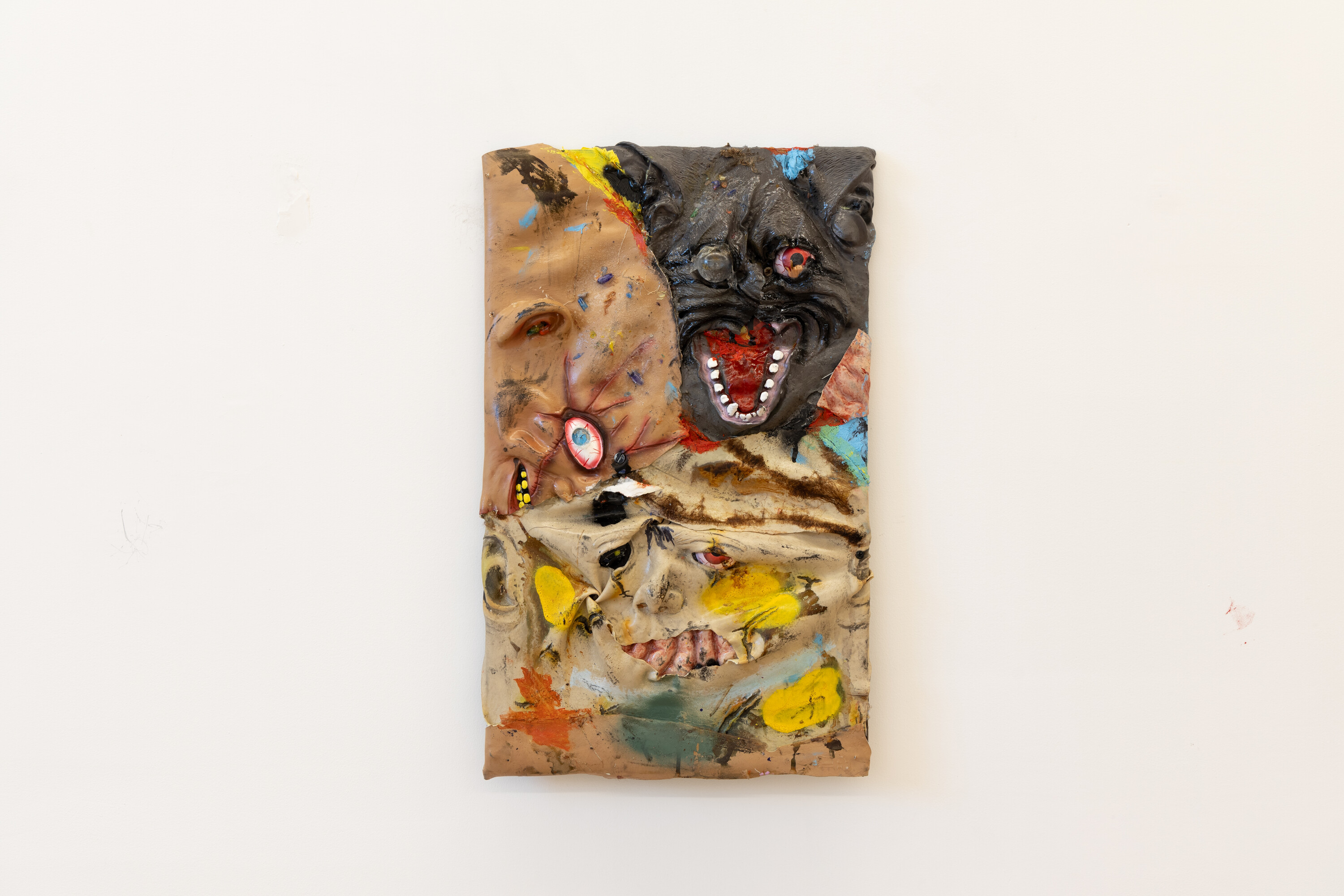
Mickey Wands All Day 2024, 33 X 53cm, Latex, silicone, oil paint, enamel and glass on wooden board. Strawberry. Photo courtesy: Nicholas Mahady and Strawberry.
Sweet consists of seven works-on-board, one work on canvas, and a video installation. One of the show’s controlling purposes seems to be to an excavation of the historical use-and-abuse of the clown by artists. To this end, the majority of the show’s works are composed of clown masks, which have been lacerated, stitched together, and flattened to wrap around MDF boards. Hughes employs techniques of fragmentation and collage to create visceral body-horror panoramas replete with hair and teeth. One particularly disgusting reference point for these works might be the dermoid cyst. Indeed, the combination of organic and inorganic materials generates a distinctly uncanny feeling: laughing clowns, loose glass teeth, peeling foil skin, and plastic eyes that pop out of skulls all represent generic nightmare material. But frankensteining these body parts together as art materials on board also produces a series of garishly artificial flat Cubist shapes and patterns.
In the bottom half of the most orthodoxly gridded work Mickey Wands All Day (2024), a white mask has been frayed and stamped to render a palimpsestic effect. This means the latex could be mistaken for raw canvas, but also for the outline of a crushed ear marking the edge of the picture. Hughes has then applied splotches of oil paint and impressionist dashes of resin to dissolve the border between mask and the board underneath. In the largest work of the show, Glass of 2024 (2024), sets of yellowed teeth are patterned in a way that might imply the picture is sequenced into a sort of triptych, but any stable orientation is totally undermined by the fact that body parts on the right side of the picture seem to have been joker-style hacked out of faces from the left. Fragmentation does not enable a holistic view of the subject from multiple perspectives in these works as it did in Cubism, but rather makes us confront the subject in actual pieces.
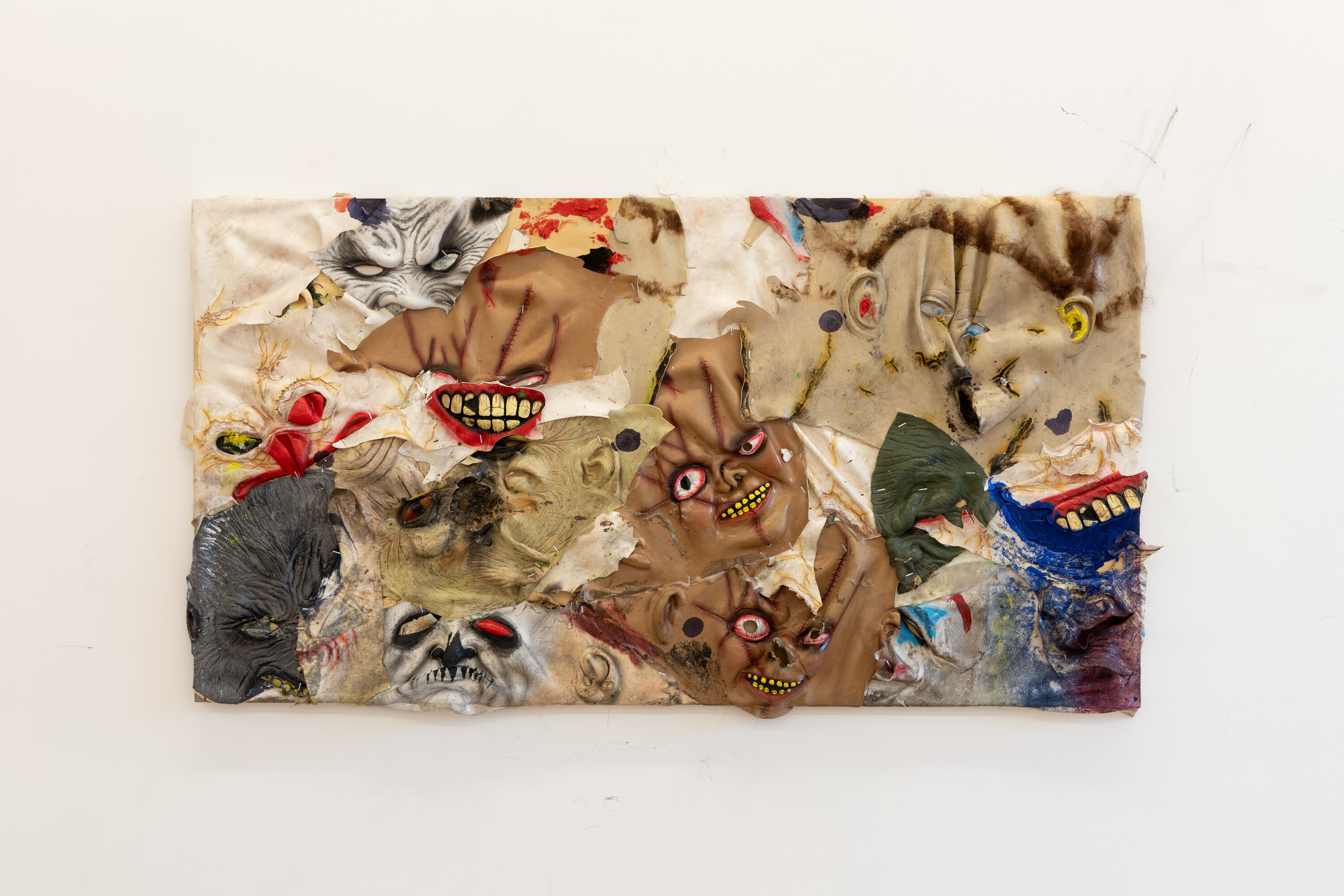
Glass of 2024 2024. 112 X 60cm, Latex, silicone, oil paint on wood board. Photo courtesy: Nicholas Mahady and Strawberry.
In this way, Hughes’s pictures invert or complicate the modernist desire for a painterly language of deracinated or spiritual abstraction. The work uses clown body-horror to thematise the return of the repressed not just in the terms of dream psychology, but in those of art history. Think of the way Picasso stripped the clown of his clothes before abandoning him for the more avant-garde pastures of the later twentieth century. The clowns in Hughes’s pictures could be screaming at the art-viewer: my culture is not your costume!
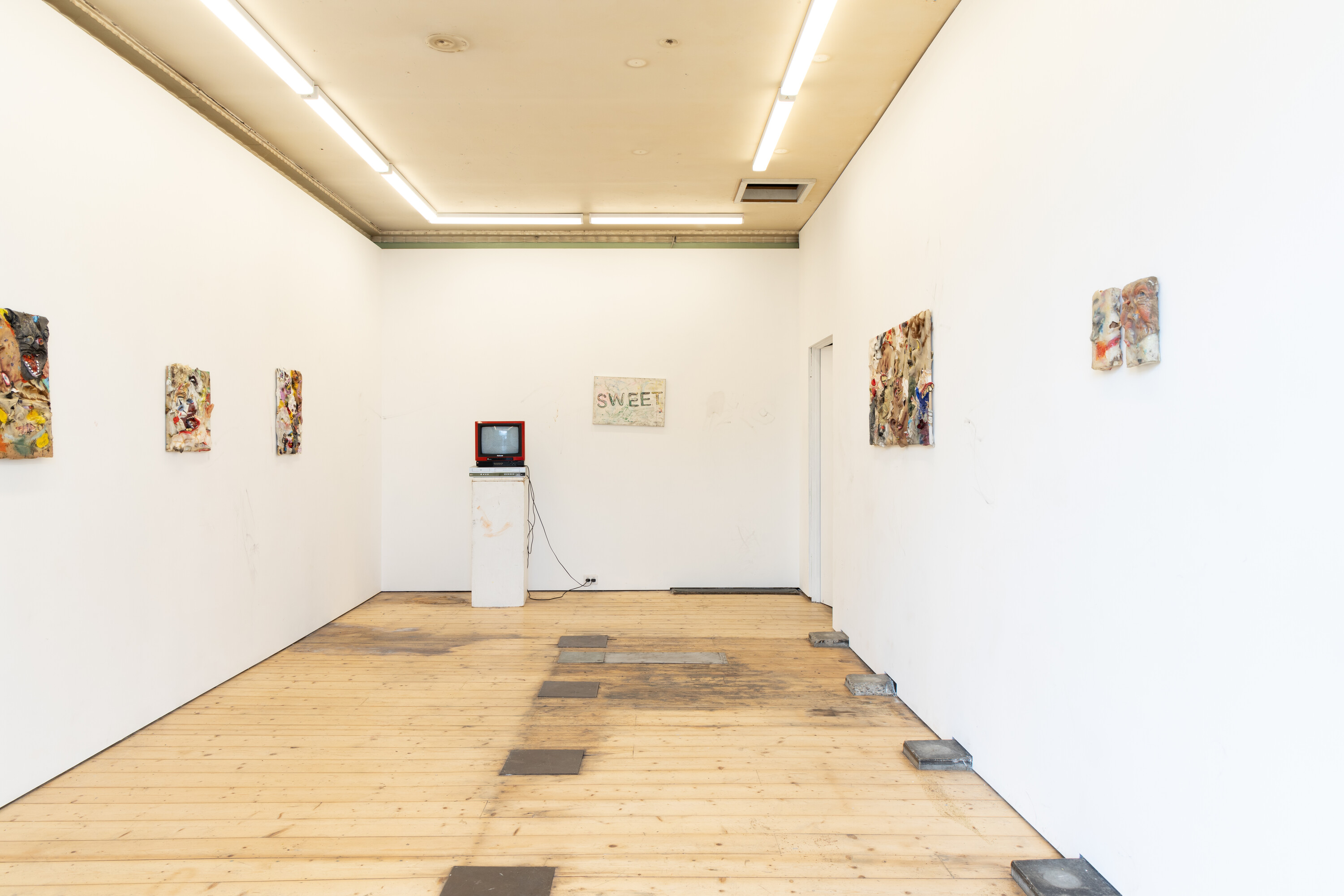
Installation view of Ben Hughes, Sweet. Left to right, Circus Crystal 2024, 40 X 40cm, Latex, silicone, oil paint, enamel and glass on wood board. The Boys 2024, 37 X 52cm, Latex, silicone, oil paint, ink on wood board. Untitled 2024, Dimensions variable, vintage Nation TV, LG VCR player, Las Vegas video (duration 20:00 mins). $weet Pussy 2024, 60 X 40cm, Oil paint and carbon residue on canvas. Glass of 2024 2024. 112 X 60cm, Latex, silicone, oil paint on wood board. Untitled 2024, 12 X 21cm, Latex, silicone, oil paint on wood. Untitled 2024, 12 X 21cm, Latex, silicone, oil paint on wood. Strawberry. Photo courtesy of: Nicholas Mahady and Strawberry
It is also important that Hughes’ pictures bear the scars of having been furiously picked over. They have all been burnt, flattened, lacerated, jabbed, and impulsively added to. There is an element of the scatter sensibility suggested in the show’s curation. The materials list (which was not available at the opening) seems to occlude a lot of the actual stuff in the works. After a cursory look, I found nails, staples, patches, plastic tags, and (my favourite) a small plastic flower all nestled in between latex folds. Also, the titular painting of the show \$weet Pussy (2024) (which thankfully just reads SWEET) is hung wonkily in the back corner of the room. It is the first thing the eye is drawn to upon entering the gallery and the only text work. By being hung skew-whiff, it looks a bit like a sign and imparts on the room a sort of dilapidated carny bar energy (Lost in St Kilda is the reference here and I recommend you go).
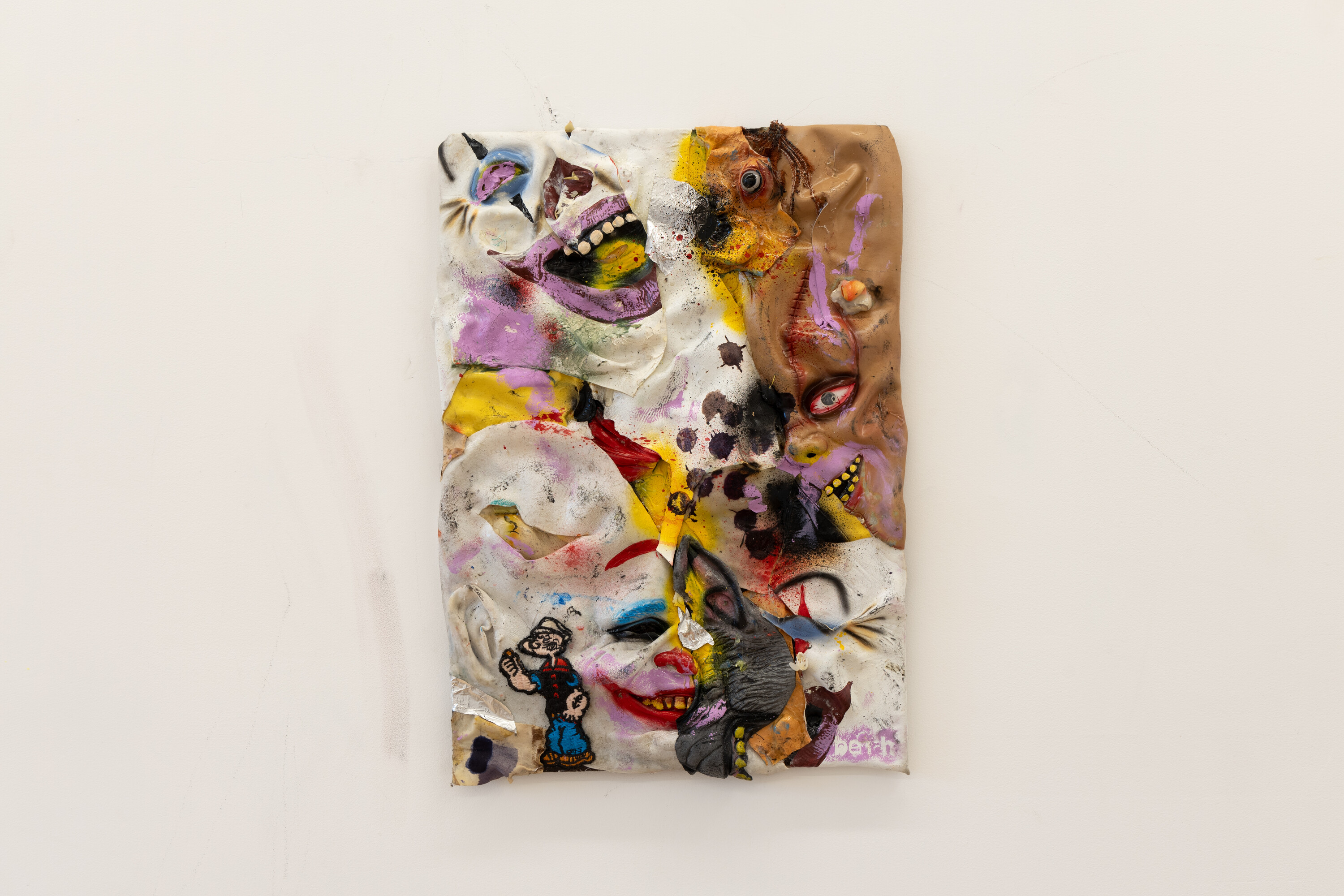
The Boys 2024, 37 X 52cm, Latex, silicone, oil paint, ink on wood board. Strawberry. Photo courtesy: Nicholas Mahady and Strawberry
Nonetheless, Hughes’s work definitively does not belong to a Karen Kilimnik type slacker art tradition. The combination of the obsessive detail of each picture with a curatorial haphazardness rather frames his practice as a sort of intensely involved amateurism. In Circus Crystal (2024) Hughes has even attempted an idiosyncratic version of the Droste effect—where a picture appears recursively in itself—a blue ink biro sketch in the bottom right corner is just visible enough to suggest it might be the rough shape of the work itself (it might also be souped-up bubble letters). Over the top of the painted clown masks in The Boys (2024), Hughes has a repurposed a Popeye patch and stuck it in the bottom left-hand corner and then graffiti-style stencilled his first name in the bottom right. These details provoke the sense that the work was produced in the bedroom of a teenage collector with pyrotechnic tendencies. This feeling of naïve but violent arrested development raises the question of whether Hughes’s work could be compared with the energies that animate Mike Kelley’s practice, for instance. Kelley’s 1988 installation at the Renaissance Society in the University of Chicago even included a small self-portrait in a glass case painted by the infamous serial killer “Pogo the clown” John Wayne Gacy during a prison art-therapy program prior to his execution. And for a more lite bad boyishness closer to home, Dale Frank’s menacing 2016 painted clown masks in liquid glass, Eric, also comes to mind.
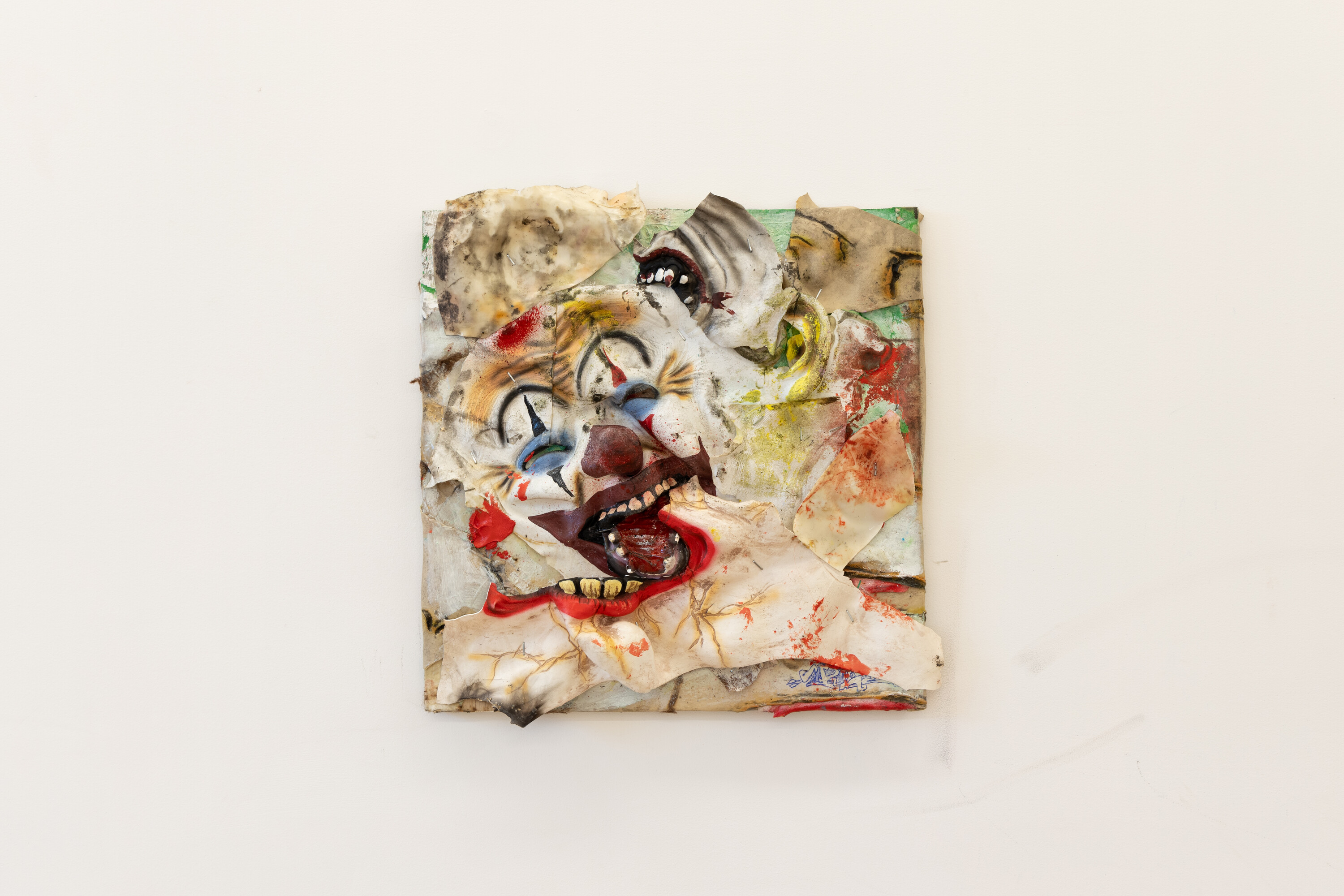
Circus Crystal 2024, 40 X 40cm, Latex, silicone, oil paint, enamel and glass on wood board. Strawberry. Photo courtesy: Nicholas Mahady and Strawberry
But no, these things are not the same. It is his furiousness that distinguishes Hughes’s work from Kelley’s or Frank’s. His clowns are not behind glass—either materially or in spirit. There is no cool poise or detachment displayed in this exhibition. Anywhere at all. The point is that Hughes’s body-horror practice literally involves flattening, burning, and destroying the conceptual distance between the artist’s hand and any kind of otherness they may wish to instrumentalise to make a clever point (Kelley) or to invest their work with a beguiling but essentially assimilable danger (Frank). In this way, Hughes’s violent handling of materials performs the transgression that is evoked but kept at bay in these other works. The implication Hughes raises through the technical violence he inflicts on the clown masks is that the artist’s interest in (and identification with) non-conventionality might not in the end be separable from a self-serving fetishisation. The artist’s work may ultimately rely on and therefore strengthen the normative conditions of exclusion and disaffection they allegedly seek out to critique. The content of Hughes’s battered, burnt, and beaten mask pictures is ironically produced by performing the dynamic by which the artist’s work keeps the clown down in order to maintain its otherness.

Untitled 2024, Dimensions variable, vintage Nation TV, LG VCR player, Las Vegas video (duration 20:00 mins). $weet Pussy 2024, 60 X 40cm, Oil paint and carbon residue on canvas. Photo courtesy: Nicholas Mahady and Strawberry
Relatedly, the repurposed VHS video about the Las Vegas casino-hotel The Golden Nugget seemed like a random inclusion to me until I was reminded of the significance of Vegas (if not The Nugget) as a classic architectural symbol of the “society of the spectacle.” I then also remembered the sad autobiographical clowns that emerged in the practices of post-modern American artists Cindy Sherman and Richard Prince right at the time they were using techniques of appropriation to ironically turn a critique of neoliberal consumerism into super-star money. An artists’ use of canny techniques to reap material and moral rewards from this sort of ruinous situation is obviously compromised, sure, but it also relies on being in the right place at the right time. In this context the appropriative possibilities afforded by Hughes’s favourite local haunt The Golden Nugget TAB, Lonsdale Street (rich though they are), are implied as particularly far away from the culture Vegas might represent in this exhibition.
What is finally confronting about this exhibition is the instability it creates for interpretation. Part of Hughes’s clown method is also to hold open the risk that any art-historical references in this exhibition could be coincidental. Like in The Substance then, the viewer is not here granted the comfortable certainty of being sure they are experiencing either a clever moral critique or guiltily enjoying the opposite. But also, like other recent examples of the body-horror genre renaissance, it is precisely this unstable pivot on which the satire, drama, and allure of Sweet turns. I’ve heard the show is selling very well.
Jeremy George is from Melbourne.